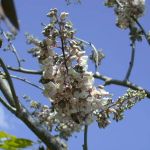| Common Name: |
Jamaica Dogwood |
| Other Names: |
Fish Poison Tree |
| Botanical Name: |
Piscidia piscipula syn P erythrina |
| Genus: |
Piscidia |
| Family: |
Fabaceae |
| Native Location: |
Mexico, Florida, West Indies |
| Cultivation: |
Deep, well-drained soil in sun with high humidity. Cut back hard after flowering to control size. |
| Propagation: |
By seed sown in spring; by semi-ripe cuttings in summer. |
| Harvest: |
Bark is collected as required, often after trees are felled for their lumber, and dried for use in decoctions, liquid extracts and tinctures. |
| Height: |
15m (50ft) |
| :Width |
10m (30ft) |
| Hardiness: |
Min. 16-18°C (61-64°F) |
| Parts Used: |
Bark of stems and roots |
| Properties: |
A bitter, acrid, sedative herb with an opium-like aroma. It relaxes spasms, controls coughing, and relieves pain |
| Medicinal Uses: |
Internally for whooping cough, asthma, neuralgia, migraine, nervous exhaustion, toothache, insomnia, painful menstruation, and postpartum pain control. Combined with Viburnium prunifolium (See, Black Haw) for gynecological problems; with Humulus lupulus (See. Hops), Passiflora incarnata (See, Maypops), or Valeriana officinalis (See, Valerian) for severe symptoms of nervous tension, such as palpitations and panic attacks. |
| Warning: |
Contraindicated during pregnancy, and in cardiac insufficiency. For use by qualified practioners only. |
| Bibliography: |
Encylopedia of Herbs by Deni Brown Copyright ©: 1995, 2001 Dorling Kindersley Limited pg 321
|
